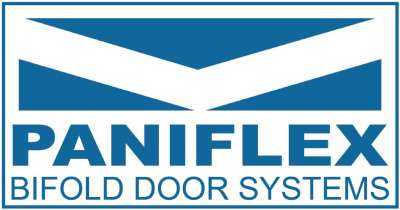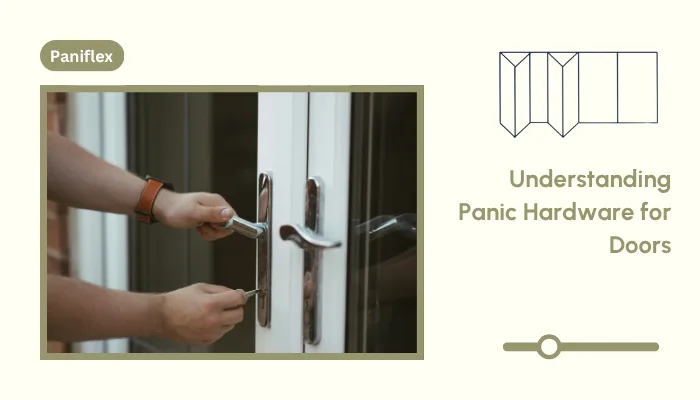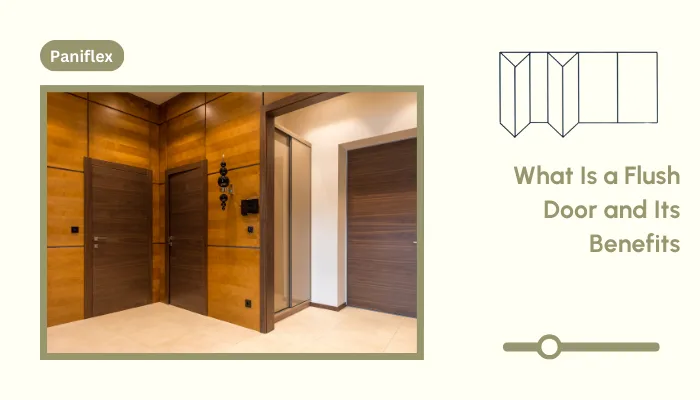Panic hardware is designed to facilitate a fast and easy exit during emergencies, eliminating the need for keys, knobs, or complicated movements. It is a safety-critical feature in high-occupancy and code-regulated spaces, such as schools, hospitals, and commercial buildings.
We understand how challenging it can be to balance safety, design intent, and compliance, especially when hardware requirements vary across occupancy types and jurisdictions. This guide explains what panic hardware is, when it is required, and how to choose the right type for each application.
Ready to experience the benefits of custom closet doors? Explore our range of Paniflex products now.
TL;DR
- Panic hardware enables fast, single-motion egress in emergencies and is required in many high-occupancy buildings.
- There are several types, including rim, mortise, and vertical rod devices—each suited to specific door setups.
- Proper installation and regular maintenance are essential for safety, compliance, and long-term performance.
- Code compliance depends on factors such as occupancy type, door rating, and mounting height; always verify local requirements.
- Integrated features, such as alarms or access control, enhance functionality but must still meet egress standards.
What Is Panic Hardware?
Panic hardware refers to a door-latching mechanism designed to allow quick, one-motion egress in emergencies, usually in the form of a horizontal push bar that unlatches the door when pressed. It is typically installed on exit doors in spaces with large occupancy loads, where fast evacuation is essential.
A standard panic device includes a push bar, internal latch or bolts, and return springs. When pressure is applied to the bar, the latch retracts, unlocking the door without the need to turn a handle or use a key. This reduces the chance of exit delay during high-stress events.
It is essential to distinguish between panic hardware and fire exit hardware. While both enable rapid egress, fire exit hardware is specifically rated for use on fire doors and must include features such as self-latching to maintain fire separation. Panic hardware, on the other hand, may be used on non-fire-rated doors and can include dogging mechanisms for hold-open functions.
Knowing what panic hardware is only solves part of the problem. To apply it correctly, it must be specified in compliance with building and fire safety codes. Here is what you need to know about code requirements and when panic hardware becomes mandatory.
Code Requirements and Compliance
Panic hardware is mandated by code based on occupancy, use, and egress requirements. Understanding when and where it is required ensures safety and helps avoid inspection failures or retrofit costs later in the project.
According to the International Building Code (IBC) and NFPA 101 Life Safety Code, panic hardware is typically required on doors in assembly, educational, and high-hazard occupancies when the occupant load exceeds 50 people. It must allow a single, non-locking motion to release the latch, and the actuator (usually a push bar) must span a minimum width of the door.
For fire-rated doors, the device must also be fire exit hardware. This means it must self-latch when closed and cannot include mechanical dogging. Electrified dogging or latch retraction may be permitted if fail-safe operation is maintained.
Additional requirements include:
- Mounting height between 34 and 48 inches from the floor
- Unrestricted operation without tight grasping, pinching, or twisting (ADA compliance)
- No key or tool required for egress from the egress side
Local amendments or interpretations by the Authority Having Jurisdiction (AHJ) may vary, so it is essential to verify regional code adaptations.
The requirement for panic hardware depends on how a space is used and the number of people it serves. The following section outlines the typical scenarios where panic devices are mandatory.
Suggested Watch: This video demonstrates where panic hardware is required by code.
Where Is Panic Hardware Required?
Panic hardware is required in buildings where large groups of people may need to exit quickly, particularly in emergencies. Its use is dictated not by design preference but by code, which considers occupancy type, occupant load, and life safety risk.
You will typically find panic hardware required in:
- Assembly occupancies (theaters, auditoriums, places of worship)
- Educational buildings (schools, daycares, colleges)
- High-hazard occupancies (labs, manufacturing facilities with hazardous materials)
- Certain retail and commercial spaces with occupant loads over 50
Any electrically locked egress door in these categories often requires panic hardware that integrates with the locking system and releases immediately upon touch, power failure, or activation of life safety systems.
In most cases, exterior exit doors from these spaces will need panic devices, even if they are not frequently used. Some interior doors that serve as part of the designated egress path may also fall under the exact requirement, especially in multi-tenant or high-occupancy buildings.
When specifying, always check the occupancy classification, occupant load, and whether the door is part of the required means of egress. This ensures that panic hardware is not only installed where it is needed but also where it is legally required.
Now that we have covered where panic hardware is required, the next step is selecting the right type for the door and building use. Each configuration serves a specific purpose, and understanding the differences can ensure code compliance and long-term performance.
Suggested Read: How to Install Sliding Closet Door Floor Guides on Various Surfaces
Types of Panic Hardware
Panic hardware comes in several configurations, each designed to suit different door styles, security needs, and building codes. Choosing the right type depends on the door’s construction, the level of traffic, and whether additional features, such as fire rating or access control, are required.
1. Rim Exit Devices
These are the most common and simplest type, mounted on the surface of the door with a latch that extends into a strike on the frame. It is ideal for single doors or the active leaf of a double door, especially when minimal door prep is preferred.
2. Mortise Exit Devices
These include a mortise lock body inside the door edge, providing a cleaner look and often higher durability. They are typically used in high-traffic environments where appearance and security are both important.
3. Surface Vertical Rod Devices (SVR)
These use rods running along the door surface to engage top and bottom latches. They are suitable for double doors without a center mullion and are often used where additional latch points are needed for stability.
4. Concealed Vertical Rod Devices (CVR)
This is similar in function to SVRs, but the rods are hidden inside the door, creating a sleek appearance. These are commonly used in glass or aluminum storefront doors or where visual continuity is important.
5. Electrified Panic Devices
These include electric latch retraction, alarm functions, or integration with access control systems. Often used in commercial buildings with keycard or security systems, they enable remote locking and unlocking without compromising emergency egress.
Each type has its own mounting requirements, maintenance needs, and compatibility considerations. Matching the device to the door’s purpose, traffic level, and safety requirements ensures reliable operation and easier compliance.
While choosing the right panic hardware type is essential, many projects also require added functionality. We will explain the most common enhancements and how they integrate into modern panic hardware systems in the next section.
From the Community: Understand compatibility between existing locking systems, panic devices, and storefront aluminum frames in this Reddit thread.
Functional Add-Ons and Integration Options
Modern panic hardware is not limited to basic mechanical egress. Many systems can be enhanced with add-ons that improve security, support access control, or meet specific use-case requirements, especially in commercial, institutional, or mixed-use facilities.
1. Alarmed Exit Devices
These units include a built-in alarm that sounds when the door is opened. They are helpful in areas where egress must remain available but where unauthorized exit or theft prevention is a concern, such as retail stores, back-of-house corridors, or emergency exits in schools.
2. Delayed Egress Systems
Delayed egress devices slow down unauthorized exit by holding the door closed for a short delay (usually 15 seconds) after someone attempts to open it. These are often used in healthcare, assisted living, or childcare facilities, where controlled movement is necessary but life safety codes still apply.
3. Electrified Latch Retraction (ELR)
This allows the latch to retract electronically when a signal is sent, enabling remote unlocking, touchless access, or integration with fire alarm systems. It is commonly used in buildings with keycard readers or automatic door operators.
4. Access Control Integration
Panic hardware can be paired with magnetic locks, card readers, electrified strikes, or push-to-exit buttons to form a complete access control system. When properly configured, these systems maintain egress compliance while controlling who can enter from the opposite side.
5. Dogging Options
Mechanical dogging holds the latch retracted to keep the door unlocked during business hours. Fire-rated doors require electrified dogging to ensure the latch engages in the event of an emergency or power loss, thereby maintaining the fire barrier.
Adding the right features to panic hardware ensures that life safety, security, and operational goals are met, without compromising code compliance. Integration choices should align with the building’s access plan and maintenance capabilities.
Specifying the proper panic hardware is only part of the job. How it is installed makes the difference between reliable performance and recurring issues. The following section outlines the key considerations to keep in mind during installation, along with common mistakes to avoid.
Suggested Read: DIY Ideas for Replacing HVAC and AC Closet Doors
Installation Considerations and Common Mistakes
Even high-quality panic hardware can fail to perform if not installed correctly. Accurate placement, proper hardware selection, and attention to door and frame conditions are all essential for ensuring smooth function and code compliance. Avoiding common mistakes at the installation stage prevents callbacks and long-term liability.
- Mounting Height and Position: Panic devices must be mounted between 34 and 48 inches from the finished floor, measured to the actuator. Mounting outside this range violates the code and can affect accessibility and ease of use.
- Improper Frame or Door Prep: Skipping manufacturer templates or using generic ones can lead to misaligned latches or binding hardware. Always verify that the door stile, material, and reinforcement match the requirements of the selected device.
- Conflict with Weatherstripping: Thick weather seals or raised thresholds can interfere with latch bolts or vertical rods, causing issues with the latch mechanism. Be sure to coordinate door gasketing with panic device specifications to prevent the device from jamming.
- Incorrect Dogging on Fire-Rated Doors: Mechanical dogging should never be used on fire-rated doors. Use only electrified dogging that can automatically relatch when required to maintain the door’s fire barrier rating.
- Lack of Testing After Installation: Every installed device should be thoroughly tested under its entire operational range. This includes checking for latch engagement and smooth actuator function.
Precision during installation has a direct impact on both life safety and day-to-day usability. Following manufacturer guidelines and coordinating with other trades early can save significant time and rework later.
Even the best panic hardware will degrade over time without proper care. Once installed, regular maintenance and inspection are key to ensuring long-term safety, smooth operation, and ongoing code compliance. This is explained in the next section.
Suggested Read: Installing Sliding Closet Doors Over Carpet
Maintenance and Inspection Best Practices
Panic hardware is often overlooked after installation, but regular maintenance is essential to ensure reliable operation, especially in buildings with high foot traffic or code-driven inspection schedules. A few targeted checks can prevent failures and reduce the need for emergency repairs.
- Inspect for Smooth Operation: Test each device periodically by pushing the bar to confirm the latch retracts fully and smoothly. If the bar sticks, returns slowly, or requires extra force, the mechanism may need cleaning, lubrication, or internal repair.
- Check Latch Engagement: Ensure the latch engages cleanly with the strike plate every time the door closes. Misalignment from hinge wear, door sag, or improper installation can prevent secure latching, compromising security and egress compliance.
- Clean Contact Points: Use a soft cloth and mild cleaner to remove dirt from the push bar, latch area, and strike. Do not use oil-based sprays or abrasive cleaners, which can attract debris or damage internal components. For electrified units, check manufacturer guidelines.
- Confirm Battery Backup (If Electrified): For electrified latch retraction or access control devices, verify wiring connections, test fire alarm integration, and check backup battery status. A system that fails during a power outage can violate life safety codes.
- Log and Schedule Regular Checks: Many jurisdictions require periodic inspections of egress hardware. Creating a documented maintenance schedule helps catch problems early and demonstrates code compliance if questioned during fire or safety audits.
Consistent maintenance ensures that panic hardware performs as designed, which is reliably, responsively, and safely under pressure. It also minimizes disruption, extends product life, and supports long-term safety in the built environment.
With proper installation and maintenance in place, the next consideration is performance over time. The following section outlines the benefits of high-quality panic hardware.
Benefits of Quality Panic Hardware
Choosing the right panic hardware is more than passing inspection. It directly impacts the building’s safety, daily usability, and long-term performance. Higher-quality devices perform better under stress, last longer, and require fewer service calls over time.
- Improved Life Safety: Reliable panic hardware ensures doors open instantly and fully when pushed, even during crowd surges or power failures. In emergencies, this reduces confusion and evacuation delays.
- Durability: Commercial-grade hardware is designed for repeated cycles and high-traffic conditions. It resists wear, spring fatigue, and mechanical failure better than entry-level options.
- Fewer Issues: Well-made devices stay aligned, latch cleanly, and tolerate minor shifts in the door or frame. This lowers the risk of sticking bars, misfires, or latch failures—common issues with low-quality systems.
- Code Compliance: High-end panic devices are tested and certified for fire rating, egress standards, and ADA compliance. This makes passing inspections smoother and reduces the need for last-minute modifications.
- Compatibility: Premium hardware often supports electrified upgrades, alarm integration, and card reader compatibility, allowing for greater flexibility without compromising life safety.
Specifying panic hardware that meets the space’s demands pays off in increased safety, reliability, and reduced liability. It is an investment in both performance and peace of mind.
By now, the types, features, and benefits of panic hardware are clear; however, selecting the correct device is where many projects encounter issues. Let’s examine why careful specification matters just as much as installation or maintenance.
Need to Match the Right Panic Hardware
Panic hardware is not one-size-fits-all. Specifying the wrong device can lead to delayed inspections, frustrated users, and costly replacements, especially in high-traffic or code-sensitive spaces. Upfront planning saves time, reduces risk, and ensures the system performs as intended from day one.
Each building has unique requirements in terms of occupancy type, security needs, door material, and fire rating. Selecting a panic device that fits those parameters minimizes field modifications and ensures compatibility with other systems, such as access control or alarm integration.
Mismatched or underperforming devices often lead to callbacks, accelerated wear, or even non-compliance. By contrast, hardware that is correctly specified and installed functions seamlessly with the door and lasts longer with minimal maintenance.
When the right panic device is chosen early in the design or build process, everyone benefits: installers face fewer surprises, the building stays compliant, and end users get a safe, intuitive egress path every time.
Ready to experience the benefits of custom closet doors? Explore our range of Paniflex products now.
Conclusion
Panic hardware plays a critical role in life safety, particularly in high-occupancy and commercial spaces. When chosen and installed correctly, it ensures smooth, code-compliant egress and minimizes risk in emergency situations.
Custom Door & Mirror offers precision-built doors that easily integrate with panic devices, closers, and access control components. Whether you are outfitting multi-unit residential, retail, or institutional projects, our doors are fabricated to exact specifications, helping to reduce jobsite adjustments and improve long-term performance.
Let us help you deliver a complete solution; code-ready, clean-fitting, and built to last. Get in touch with us today.
Frequently Asked Questions
What are the requirements for panic hardware for doors?
Panic hardware is required on certain doors in high-occupancy or hazardous-use buildings. It must allow single-motion egress without tools, be mounted 34–48 inches from the floor, and meet fire rating and ADA guidelines where applicable.
What are the different types of panic hardware?
Common types include rim exit devices, mortise exit devices, surface vertical rod (SVR), concealed vertical rod (CVR), and electrified versions. Selection depends on door configuration, traffic level, fire rating, and whether access control integration is needed.
How does panic hardware work?
Panic hardware allows a quick exit by retracting the latch when the push bar is pressed. It requires no key or twisting motion and is designed to operate under pressure during emergencies, even in low visibility or panic situations.
Is panic hardware considered a latch?
Yes, panic hardware includes a latching mechanism. However, unlike standard latches, it must release instantly with a push. On fire-rated doors, it must self-latch to preserve the fire barrier, making it both a latch and a life safety device.






